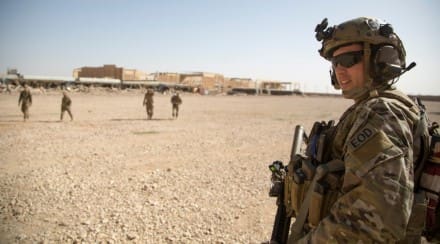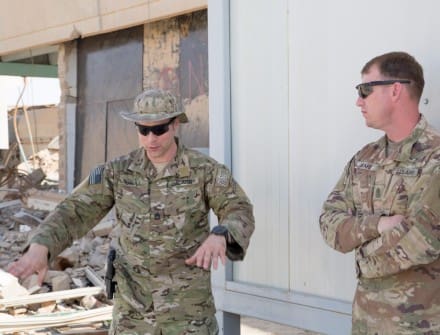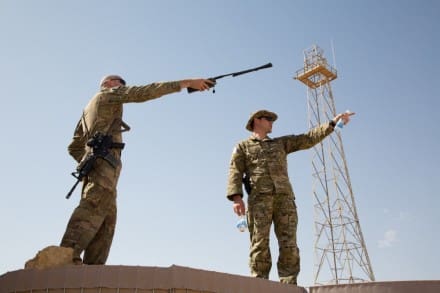The U.S. Army’s Asymmetric Warfare Group (AWG), headquartered at Fort Meade, Maryland, selects, trains, and prepares the most qualified applicants to become Operational Advisors (OAs). Operational Advisors are subject matter experts in their field. They are seasoned warriors who support Army and Joint Force Commanders to enhance Soldier survivability and combat effectiveness, and enable the defeat of current and emerging threats in support of Unified Land Operations.
Operational Advisors are senior enlisted Soldiers (Sgt. 1st Class and above), Officers (Capt. to Lt. Col.) and Consultants. Most of the consultant Operational Advisors are combat veterans with Special Operations background, who were once senior ranking enlisted and officers, and are now retired from the military. The consultants continue their service supporting AWG deployed in theater and stateside by mentoring, coaching, and providing guidance to the active duty Operational Advisors. These OA consultants are a critical asset to the organization and assist in the overall completion of the mission. All OAs communicate with each other to spread the knowledge from their observations past and present across the formation.
The Asymmetric Warfare Group has a worldwide focus with regionally aligned squadrons. Traveling in small teams, OAs must also be able to accomplish the mission individually with ambiguous instruction to meet the Commanders Intent. As the OAs prepare to conduct a mission, they will gather information that allows them to identify the initial threat situational template and understand the Operational Environment. The OA will then embed with units and gather first hand observations on enemy tactics, techniques, and procedures (TTPs) to increase their situational understanding of the threat. As an external observer, AWG OAs can then assist commanders with material or non-material solutions to provide a time sensitive upper hand in a complex and fluid environment. Operational Advisors will think, adapt, and anticipate ensuring mission success.
It is clear that AWG places emphasis on readiness of all personnel prior to deploying into a combat zone. As a Combat Cameraman (COMCAM) in support of the Asymmetric Warfare Group, I received an extensive amount of training to prepare myself for most missions during my assignment. (This training is a requirement for all OAs, Operational Advisory Support Personnel, and consultants in the organization regardless if scheduled to deploy or not.) I attended the Combat Skills Training Course (CSTC) where advanced and refresher tactics such as shoot, move, communicate, and medicate skills are taught. In addition to immediate and remedial drills, transition drills from primary to alternate weapons, barrier shooting, and several shooting positions are enforced through scenario driven events. I received a class on different communication platforms and their tactical applications in combat. The medical training was an introduction to mass casualty situations and how to categorize patients for treatment and evacuation if an event became catastrophic. I also attended an IFAK (Individual First Aid Kit) 101 class to get familiarized with all equipment in the personal medical aid kit and how to properly use it. The medic cannot save everyone, but with helping hands from combat lifesavers many battlefield deaths have been prevented simply by someone stopping the bleeding of a casualty. First Aid is a high pay off task and Operational Advisors and OA support personnel go through extensive training to maintain proficiency on this skill.
Integration is a major component of becoming part of the team. After completing CSTC, Charlie Squadron members provided further mentoring to complete additional training and prepare for deployment. Additionally, I attended weekly briefings alongside senior members of the squadron to gain situational awareness of the areas I could be providing support. The squadron’s logistician ensured I was ready to deploy and coordinated for issue of AWGs equipment and weapons. They worked hand in hand assisting me to make sure I had everything I could possibly need in combat and so I could be outfitted and look similar to the advisor I would be shadowing. They helped me coordinate the shipment of my equipment overseas; thus making the deployment official.
I had the unique opportunity to deploy in May, 2018 with Sgt. 1st Class Roberto (Rob) Crull, an AWG Explosive Ordnance Disposal Advisor from Charlie Squadron to Iraq, as he supported units during Operation Inherent Resolve (OIR). I was able to witness first hand how an advisor works from getting into country, to coordinating embeds with an operational element. Prior to departure from the AWG hub in Iraq, we prepared equipment to be self-sufficient so that we would not be a burden on the supported unit. I learned that AWG has the capability to establish expeditionary communications via BGAN (Broadband Global Area Network) for secure communication in remote locations. Sgt. 1st Class Crull established a point of contact with the unit to make sure that they could accommodate our stay in their area of operations. Sgt. 1st Class Crull stated that “an OA should never be a hindrance to a unit he/she embeds with. An OA brings everything they need to establish all forms of communications to include solar kits for power for when in austere environments.”
Upon arrival to the unit we were supporting, Sgt. 1st Class Crull met with leadership, introduced himself, gave a capabilities brief on his role, why he was in their area of operations, and presented an overview of what he was looking to accomplish. Once communication was established within the unit, I witnessed the relationships immediately grow between Sgt. 1st Class Crull, unit leaders, and the Soldiers around the area. Sgt. 1st Class Crull quickly became an icon as many Soldiers opened up to him with the many challenges they faced. Sgt. 1st Class Crull and I made ourselves a part of that team by sleeping in the transient tent with the Soldiers versus being in a VIP tent away from unit members, which is what the camp mayor was trying to do out of generosity. A humble servant spirit is necessary to operate with AWG.
An incident occurred during my time with him where the supporting unit had to respond to a Fallen Angel crisis in their area of operations. Sgt. 1st Class Crull’s past experience in Fallen Angel incidents and mine in forensic photography to assist investigators played a vital role in this unfortunate situation. Sgt. 1st Class Crull was able to integrate us into the flow of operations to assist during the crisis. We loaded into vehicles and moved out with the Quick Reaction Force (QRF) to the site. My initial impression was that this was enemy related and my training prepared me to respond with force if necessary. I was ready to perform my duties as a Soldier and secure the site. My training allowed me to be confident in my abilities and calm under stress, but also to respond accordingly. Nothing can prepare you mentally for how to respond to all situations. It is true what they say, in stressful situations your training will kick in and it’s like you automatically know what you have to do. Once the scene was secure and all heroes were recovered from the site, I switched from rifleman to a combat photographer. I began to take photos of the scene to paint the picture for the investigators before the scene could have been contaminated from wind or operational disturbance.
Unit members in the supported unit, valued the knowledge that Sgt. 1st Class Crull presented. Before our departure from the unit, Sgt. 1st Class Crull was able to provide advice and “Make the Unit in Contact Better”. I learned that an Operational Advisor has extensive resources and reach back capabilities, providing the units in contact with rapid solutions. Everything the OA does is based on building relationships within units and earning their trust. The supporting unit was very thankful and opened the doors for him to return. Sgt. 1st Class Crull bolsters the term “quiet professional” and is a great representation of AWG. This was a great experience and I was able to see how AWG operates from a tactical and operational perspective.
The OAs job is never-ending. Upon returning to the states they must gather their observations from the duration of the deployment for post mission dissemination. Those observations are non-attributable towards any specific unit, and identify ways to properly assist the fighting force to defeat current and future threats. The process then starts over and the OA will engage with units during home station training and also at the Combat Training Centers (CTC) to support the next deployment.
When talking to Sgt. 1st Class Crull during one of my days with him, he stated the Charlie Squadron Commander’s vision and in his own words what an AWG Operational Advisor does:
“We strive to make units in contact better by understanding the enemy and the complex operating environment while moving to the sound of guns. AWG is not there to tell a unit they are doing things wrong, we are there to identify outdated doctrine and friendly TTPs so that units in contact can adapt. Successes of operational solutions can then be carried forward to units deploying and currently deployed across the globe” Lt. Col. Kirk Liddle, Charlie Squadron Commander.
Earning the title of an Operational Advisor is not for everyone. The job is very demanding, but the rewards are endless. Once you are part of the Asymmetric Warfare Group, you become part of the AWG family. Families make lifelong bonds through the unique experience of a high operations tempo environment. If you wish to make a difference and be part of the solution, apply for selection at www.awg.army.mil.
Photos feature U.S. Army SSG Jeremiah Hall and SFC Roberto Crull, an Explosive Ordnance Disposal (EOD) Operational Advisor with Charlie Squadron, Asymmetric Warfare Group, waits at a landing zone for transport at a Forward Tactical Assembly Area in Al Anbar Province, Iraq, Mar. 22, 2018. AWG provides operational advisory support globally and rapid solution development to enhance survivability and combat effectiveness, and enable the defeat of current and emerging threats in support of Unified Land Operations. (U.S. Army photo by Sgt. Randis Monroe)
Story by SGT Randis Monroe, AWG
Tags: Asymmetric Warfare Group






What a tool.
How so?